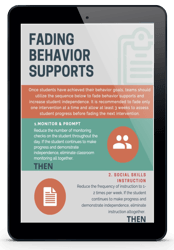It’s like learning to ride a bike.
Developing an intervention fading plan for your students.
Independence. That is our goal as we work with students to navigate learning behavior. But how do we get there?
Let me give you a visual.
It's a summer morning, and with much anticipation, your son is ready to take his bike out for its first ride. He knew today was the day and couldn't stop talking about the excitement of the cherry red bike he got for his birthday.
You meet him in the garage, help him strap on his matching cherry red helmet and his shoulder and knee pads, and show him his bike. Dad added a fancy horn to the bike handle so he could announce his new adventures.
"All set?" you ask. "YES!" your son leaps in excitement. You hold the bike handles steady as he climbs onto the seat. A little bit of fear shows up in his eyes as he feels the bike wobble, but the fear turns to determination as he looks up at you and asks, "You'll be here with me, right, Mom?" You answer, "For as long as you need me!"
He starts pedaling, and you jog beside him, holding the handlebars as he feels the wheels hitting the road. His silent focus turns into giggles, and you can feel him relax into the bike's feel.
You take one hand off the handlebars, and he wobbles slightly but stays steady. You shift your hand to hold the bike seat and slowly take off your other hand on the handlebars. "Mom, I'm doing it!" he yells.
He hits a rock on the road with his tire and loses balance. You see his eyes get wide as he tries to keep steady. You jump in and put your hands back on the handlebars to slow him down. You ask him to put his feet on the ground when you're stopped. "See, you're stable now. If that happens again, you can always slow down and put your feet on the ground to help you feel balanced."
With some hesitation, he starts riding again, and you hold the handlebars with him. He picks up speed and confidence, so you slowly return to holding the bicycle seat. You test out jogging next to the bike while taking your hand off the seat, and he stays steady, so you keep moving next to him as he goes down the sidewalk.
When he's ready to turn around, you put your hands back on the handlebars and help show him how to make a turn. You both make it back to the driveway, and your son jumps off the bike excitedly, and you see his confidence shining through. He did it. He rode his bike. Oh, what great adventures he will have. "Thanks, Mom! Maybe next time, I can do it all on my own!"
Now, transport back into the classroom.
The school year begins, and you immediately notice a student struggling to interact with her classmates. She often gets angry with others, and you sometimes find her alone during recess. You decide to check in with the student the next morning before they start their day.
In the morning, you talk with the student and discover some challenges at home, making her feel sad at school. You find out she didn't have breakfast that morning, so you help her get something to eat. Both of you agree that you'll check out at the end of the day, and you let her know she can come and talk to you throughout the day if she needs to.
You keep an eye on her progress throughout the day and notice different things that might be causing her trouble, so you put some plans in place to review with her the next day and some support for bringing her confidence back.
As you enter the second semester, you reflect on the past weeks when you've watched your student grow and gain confidence. The intervention plan you put in place to support her has been so helpful that you can now decrease the frequency and see her flourish independently. You've even often found her at the center of activities with her peers.
Supports, whether at school or home riding a bike, are necessary to help kids build confidence and independence to tackle the challenges in their days.
If our ultimate goal is independence for a student, then we have to put a plan in place to help them move toward the independent application of their behavior skills. We call this fading interventions. An intervention fading plan will look different for each student, but we can slowly adjust the student's intervention routine to gradually reduce the external supports the student needs. With a well-designed intervention fading plan, we can begin to see our students take ownership of the skills they've been taught and perform them without needing prompts.
Here's a guide to fading interventions in the context of the intervention routine we use at Emergent Tree:
1. Practice Social Skills
We're seeking independence in their daily engagements and as they work with others. Working together as a group to practice social skills will help increase the confidence your students have. You'll start to identify if there are changes in behavior when the students work together and who might need additional supports throughout this type of environment.
As you reflect on your student's progress, you can see that she has worked hard to learn new behavior skills and consistently demonstrates them during social skills lessons. You rarely have to prompt the student during social skills now, and you have even seen her applying the learning to new situations and people! This is an excellent time to begin reducing the amount of social skills instruction the student receives. If the student received daily social skills instruction, consider dropping it to 2 or 3 times a week. Then once a week and eventually none at all!
2. Monitor & Prompt
First, we must start with the data. Identify patterns of when challenges arise for the student. When are they most successful, and when do they struggle? Are there any environmental changes that might be triggering the different behaviors?
Keep track of the frequency of prompts and note when you need to provide higher levels of support and when the student is more independent. You may find prompting occurs every hour or more initially, but as the student acquires new behavior skills, you'll likely see a decrease in the frequency of the need for prompting. Instead of checking on your student every hour, consider lowering the frequency to 4 or 5 times throughout the day.
3. Provide Direct Feedback
Throughout the fading process, students need feedback to know how they are doing - both positive and behavior-correcting. If they are improving on skills, they need to know it and experience positive feedback for the work they've invested in! If the student demonstrates independence, begin reducing the frequency of direct feedback. If the student continues to be successful with increasing independence, start fading feedback to typical classroom ratios.
4. Check-in/Check-out
One of the best processes we've seen support not only a student but also the teachers and staff is the Check-in/Check-out process. This intervention frequently leads to strong, trusting relationships between students and their Check-in/Check-out mentor. Check out our course on this intervention for guidance on successful implementation.
The relationships developed through Check-in/Check-out are valuable and can continue even when the student no longer receives other intervention supports. You can begin to fade Check-in/Check-out by first eliminating Check-out. Continue to monitor progress and maintain the supportive relationship while you work toward eventually eliminating Check-in also. As a student's need for support fades, the Check-in/Check-out mentor should maintain the relationship and connection even though it is no longer scheduled within daily structures.
The fading interventions aim to empower students as they grow into successful, independent young people. We slowly move them to higher levels of independence by reducing the intensity of support and increasing access to the naturally occurring supports available in the school environment.
We want students to access their education in the least restrictive environment possible.
What kind of independent behaviors should we be looking for?
Independence will vary depending on the student, but here are some commonalities you can start to keep an eye out for with your students:
- Self-advocating; requesting help or accommodations when needed
- Managing conflict with peers
- Managing school materials independently
- Leveraging learned strategies to use when they encounter a problem
Just like learning to ride a bike, there may be variables or new environments the student is exposed to that may impact how they respond. Taking things slow and monitoring these changes will help you identify any potential shifts. We suggest allowing these independent behaviors to flourish for three weeks consistently before you start to fade out subsequent interventions.
.png?width=1080&height=1080&name=Some%20advice%20for%20the%20road%20(1).png)
Some advice for the road:
- Consider independence the minute you begin interventions. Everything you teach will get you closer to independence, and this will drive your instruction.
- Go in with a plan. As a team, determine the steps for fading interventions, make a plan for continued data collection, and establish criteria for moving through the steps of the fading plan.
- Take it slow. Once we get to a point where we see the students using their skills, we need to make sure we fade them to successful independence without pulling the rug out from under them (doing too much too soon). Let your data drive decisions for intervention fading.
Make a plan and take it slow. Constantly reflect on your data to determine your next steps.
Ready to create an Intervention Plan?
We have a simple and easy guide to help you navigate the steps and keep them top of mind.
Reflecting on your data is a key part of your intervention plan. Check out our Progress Monitor to help you visually express the independence levels of your students and help track data.


 Download Now.
Download Now. 
Comments